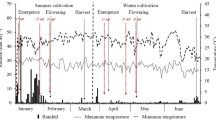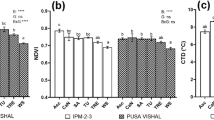Abstract
The effect of brassinosteroids (BRs) was tested, in order to assess the possibility of alleviation of the adverse effects of high temperature stress on snap bean plants during delayed summer cultivation. Therefore, two field experiments were carried out in successive seasons, 2010 and 2011, with two bean cultivars ‘Paulesta’ and ‘Oxzira’, spraying with BRs of the following concentrations 0 (control), 25, 50 and 100 ppm. Plant growth, yield and pods quality of beans were studied. Spraying bean plants with BRs at a concentration of 25 and 50 ppm increased vegetative growth, total yield and quality of pods with no significant difference between both treatments. Using BRs at 25 ppm increased the total free amino acids (FAA) in leaves and total phenolic acids in the pod in comparison to control-treatment. ‘Oxzira’ cultivar resulted in the highest number of leaves, number of branches, dry weight of whole plant, total yield, total FAA in leaves and total phenolic acids in pod. Whereas, ‘Paulesta’ cultivar had the highest of plant length and total FAA in pods.
Zusammenfassung
In der vorliegenden Arbeit wurde untersucht, inwiefern Brassinosteroide (BRs) den oxidativen Stress durch hohe Temperatureinwirkungen bei Brechbohnen während eines verzögerten Sommeranbaus verringern. Dazu wurden zwei Feldversuche mit den zwei Bohnensorten ‘Paulesta’ und ‘Oxzira’ durchgeführt. Besprüht wurden die Pflanzen mit BRs in folgenden Konzentrationen 0 (Kontrolle), 25, 50 und 100 ppm in den Jahren 2010 und 2011. Pflanzenwachstum, Ertrag und Qualität der Brechbohnen wurden untersucht. Das Besprühen der Bohnenpflanzen mit BRs bei einer Konzentration von 25 und 50 ppm erhöhte das vegetative Wachstum, den Gesamtertrag und die Qualität der Hülsen. Es konnte kein signifikanter Unterschied zwischen den beiden Behandlungen festgestellt werden. Bei der Verwendung von einer Konzentration von 25 ppm erhöhten sich – im Vergleich zur Kontrolle – die gesamten freien Aminosäuren (FAA) in den Blättern sowie der Phenolsäuregehalt in den Hülsen. Die Sorte ‘Oxzira’ zeigte die höchste Anzahl an Blättern und Verzweigungen, Trockengewicht, Gesamtertrag, FAA in Blättern und Phenolsäure in den Hülsen. Die Sorte ‘Paulesta’ hatte dagegen die größte Pflanzenhöhe und FAA in den Hülsen.
Similar content being viewed by others
References
Ali B, Hayat S, Hasan SA, Ahmad A (2006) Effect of root applied 28-homobrassinolide on the performance of Lycopersicon eculentum L. Sci Hortic 110:267–273
Ali B, Hasan SA, Hayat S, Hayat Q, Yadav S, Fariduddin Q, Ahmad A (2008) A role of BRs in the amelioration of aluminium stress through antioxidant system in mung bean (Vigna radiate L. Wilczek). Environ Exp Bot 62:153–159
AOAC (1990) Official methods of analysis. 15th edn. Association of Official Analytical Chemists, Washington DC
Bajguz A, Hayat S (2009) Effects of brassinosteroids on the plant responses to envi-ronmental stresses. Plant Physiol Biochem 47:1–8
Behnamnia M, Kalantari KM, Rezanejad F (2009) Exogenous application of brassinos-teroid alleviates drought-induced oxidative stress in Lycopersicon esculentum L. General Appl Plant Physiol 35(1–2):22–34
Clouse SD, Sasse JM (1998) Brassinosteroids: essential regulators of plant growth and development. Annu Rev Plant Physiol Plant Mol Biol 49:427–451
Danial HD, George CM (1972) Peach seed dormancy in relation to endogenous inhibitors and applied growth substances. J Am Soc Hort Sci 17:651
Dhaubhadel S, Chaudhary S, Dobinson KF, Krishna P (1999) Treatment of 24-pibrassinolide, a brassinosteroid, increases the basic thermotolerance of Brassica napus and tomato seedlings. Plant Mol Biol 40:333–342
Dhaubhadel S, Browning KS, Gallie DR, Krishna P (2002) Brassinosteroid functions to protect the translational machinery and heat-shock protein synthesis following thermal stress. Plant J. 29:681–691
Fariduddin Q, Hasan SA, Ali B, Hayat S, Ahmad A (2008) Effect of modes of application of 28-homobrassinolide on mung bean. Turk J Biol 32:17–21
Gomez KA, Gomez AA (1984) Statistical procedures for agriculture research, 2nd edn. Wiley-Interscience, New York
Grove MD, Spencer FG, Rohwededer WK, Mandava NB, Worley JF, Warthen JD Jr, Steffens GL, Flippen-Anderson JL, Cook JC Jr (1979) Brassinolide, a plant growth promoting steroid isolated from Brassica napus pollen. Nature 281:216–217
Hasan SA, Hayat S, Ali B, Ahmad A (2008) 28-homobrassinolide protects chickpea (Cicer arietinum) from cadmium toxicity by stimulating antioxidants. Environ Pollut 151:60–66
Hayat S, Ahmad A, Hussain A, Mobin M (2001) Growth of wheat seedlings raised from the grains treated with 28-homobrassinolide. Acta Physiol Plant 23:27–30
Howell WM, Keller GE 3rd, Kirkpatrick JD, Jenkins RL (2007) Effects of the plant steroidal hormone, 24-epibrassinolide, on the mitotic index and growth of onion (Allium cepa) root tips. Genet Mol Res 6:50–58
Ibrahim SK, Shalaby MAF, El-Said Zaki M, Abou-Sedera FA, Abd Allah MSA (2012) Alleviation of high temperature stress on snap bean (Phaseolus vulgaris L.) by benzyl adenine and putrescine. J Appl Sci Res 8(1):192–199
Jian YP, Cheng F, Zhou YH, Xia XJ, Shi K, Yu JQ (2012) Interactive effects of CO2 enrichment and brassinosteroid on CO2 assimilation and photosynthetic electron transport in Cucumis sativus. Environ Exp Bot 75:98–106
Kang YY, Guo SR (2011) Role of brassinosteroids on horticultural crops. In: Hayat S, Ahmad A (eds) Brassinosteroids: a class of plant hormone. Springer, Dordrecht, pp. 269–288
Karas AN, Singer SM, Sawan OM, Abou Hadid AF (1999) Water consumption of bean plants (Phaseolus vulgaris L.) as affected by sowing dates. Egypt J Hort 26:19–34
Konsens I, Ofir M, Kigel J (1991) The effect of temperature on the production and abscission of flowers and pods in snap bean (Phaseolus vulgaris L.). Ann Bot 67:391–399
Krishna P (2003) Brassinosteroid-mediated stress responses. J Plant Growth Regul 22(4):279–289
Kulaeva ON, Burkhanova EA, Fedina AB, Khokhlova VA, Bokebayeva GA, Vorbrodt HM, Adam G (1991) Effect of brassinosteroids on protein synthesis and plant cell ultrastructure under stress conditions. In: Cutler HG, Yokota T, Adam G (eds) Brassinosteroids: chemistry, bioactivity and applications, ACS symposium, Ser. 474:141–155. American Chemical Society, Washington, DC
Mai YY, Lin JM, Zeng XL, Pan RJ (1989) Effect of homobrassinolide of the activity of nitrate reductase in rice seedlings. Plant Physiol Commun 2:50–52
Masaya P, White JW (1991) Adaptation to photoperiod and temperature. In: Van Schoonhoven A, Voysest O (eds) Common beans-research for crop improvement. CIAT, Cali, pp. 445–500
Mitchell JW, Mandava NB, Worley JF, Plimmer JR, Smith MV (1970) Brassins: a new family of plant hormones from rape pollen. Nature 225:1065–1066
Monterroso VA, Wien HC (1990) Flower and pod abscission due to heat stress in beans. J Am Soc Hort Sci 115:631–634
Nomura T, Nakayama M, Reid JB, Takeuchi Y, Yokota T (1997) Blockage of brassinosteroid biosynthesis and sensitivity causes dwarfism in garden pea. Plant Physiol 113:31–37
Ogweno J, Xing Song, Kai Shi, Hu Wen, Wei Mao, Yan Zhou, Yu Jing, Salvador No-gués (2008) Brassinosteroids alleviate heat-induced inhibition of photosynthesis by increasing carboxylation efficiency and enhancing antioxidant systems in Lycopersicon esculentum L. J Plant Growth Regul 27:49–57
Omae H, Kumar A, Kashiwaba K, Shono M (2006) Influence of high temperature on morphological characters, biomass allocation, and yield components in snap bean (Phaseolus vulgaris L.). Plant Product Sci 9(3):200–205
Pinol R, Simon E (2009) Effect of 24-epibrassinolide on chlorophyll fluorescence and photosynthetic CO2 assimilation in Vicia faba plants treated with the photosynthesis-inhibiting herbicide terbutryn. J Plant Growth Regul 28:97–105
Plummer D (1978) An introduction to practical biochemistry, 2nd edn. McGraw-Hall Mook, London, pp 144
Prasad PVV, Boote KJ, Allen LH Jr (2002) Effects of elevated temperature and carbon dioxide on seed-set and yield of kidney bean (Phaseolus vulgaris L.). Global Change Biol 8:710–721
Saini JP, Negi SC (1998) Effect of sowing on growth and yield of french bean (Phaseolus vulgaris L.) under dry temperate condition. Indian J Agron 43:110–113
Singh I, Shono M (2005) Physiological and molecular effects of 24-epibrassinolide, a brassinosteroid, on thermotolerance of tomato. Plant Growth Regul 47:111–119
Torres W, Nunez M (1997) The application of biobras-6 and its effect on potato (Solanum tuberosum L.) yields. Cultivos Trop 18:8–10
Wilen RW, Sacco M, Gusta LV Krishna P (1995) Effects of 24- epibrassinolide on freezing and thermotolerance of bromgrass (Bromus inermis) cell cultures. Plant Physiol 95:195–202
Xia XJ, Wang YJ, Zhou YH, Tao Y, Mao WH, Shi K, Asami T, Chen Z, Yu JQ (2009) Reactive oxygen species are involved in brassinosteroid-induced stress tolerance in cucumber. Plant Physiol 150(2):801–814
Zhu BC, Su J, Cham MC, Verma DPS, Fan YL, Wu R (1998) Overexpression of pyrroline-5-carboxylate synthetase gene and analysis of tolerance to water stress and salt stress in transgenic rice. Plant Sci 139:41–48
Author information
Authors and Affiliations
Corresponding author
Rights and permissions
About this article
Cite this article
El-Bassiony, A.M., Ghoname, A., El-Awadi, M. et al. Ameliorative Effects of Brassinosteroids on Growth and Productivity of Snap Beans Grown Under High Temperature. Gesunde Pflanzen 64, 175–182 (2012). https://doi.org/10.1007/s10343-012-0286-x
Received:
Accepted:
Published:
Issue Date:
DOI: https://doi.org/10.1007/s10343-012-0286-x




